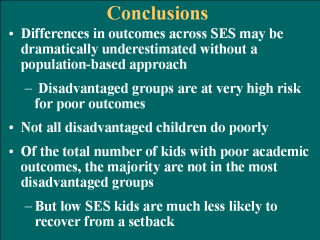| front |1 |2 |3 |4 |5 |6 |7 |8 |9 |10 |11 |12 |13 |14 |15 |16 |17 |18 |19 |20 |review |
 |
It is clear a child’s progression through the
school system is strongly related to socioeconomic status. Children and
youths from socioeconomically deprived areas generally have poorer
educational outcomes than those from more affluent areas. However,
population-based data demonstrate that traditional methods of assessing the
relationship between socioeconomic status and educational achievement
profoundly underestimate its strength. The traditional testing process
misses all those who fall behind their classmates and all those who leave
school. Hence, we consistently underestimate the handicaps associated with
low socioeconomic status and fail to develop policies that enable children
to overcome them.
Not all disadvantaged children do poorly; in fact, most of those who make it to Grade 12 to write the test pass. The problem is that a large proportion of low-SES kids do not make it to Grade 12 on time or at all.
It should also be noted that the number of children with poor academic performance is not greatest in the most disadvantaged groups, but the lower-SES children are much less likely to recover from setbacks than children from higher-SES groups. |